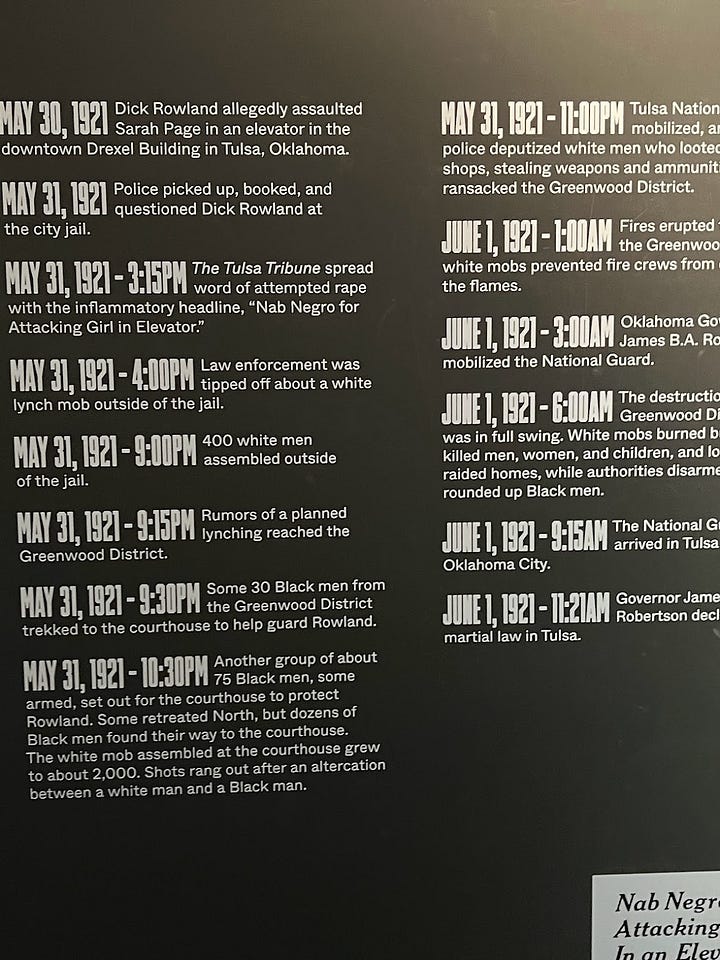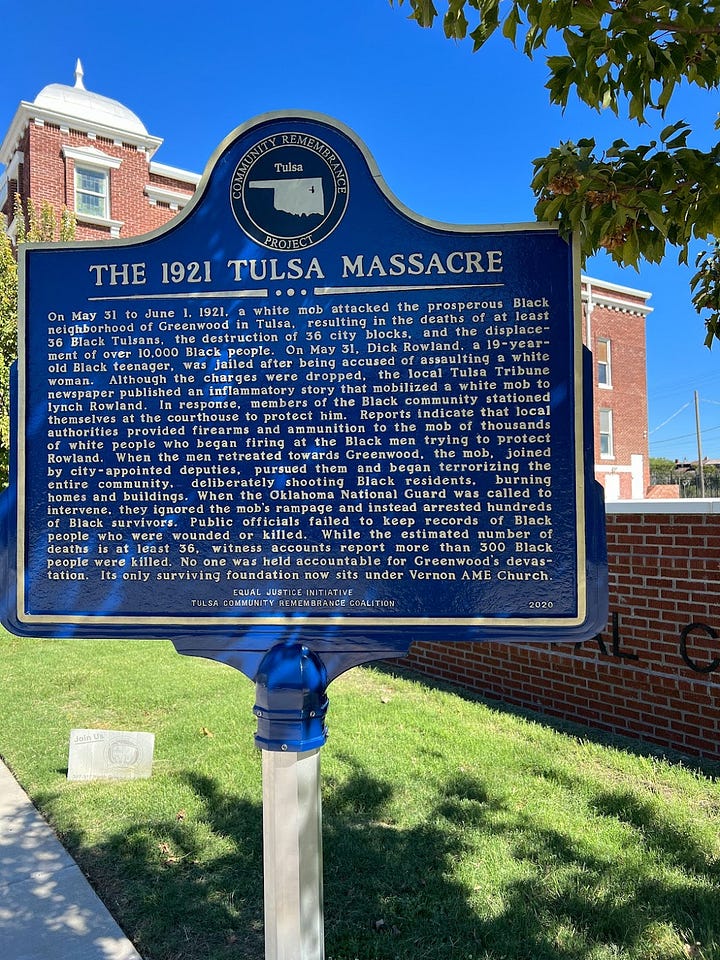Magic City and the Tulsa Massacre
Reading about and visiting Black Wall Street, Greenwood Rising, and Tulsa
A book to read: MAGIC CITY by Dr. Jewell Parker Rhodes
I’d read GHOST BOYS by Jewell Parker Rhodes a few years ago, so knew her as a stellar author of powerful children’s books. I was thrilled when I’d learned that she’s written adult books as well.
GHOST BOYS is a middle grade novel about a Black boy who is shot and killed by the police. In the ghost world, he meets the ghost of Emmett Till.1
I’ve also met Jewell Parker Rhodes daughter. Kelly McWilliams is the author of the YA contemporary YOUR PROM PLANTATION IS NOT OKAY. Kelly and I live in the same area and she’s often at literary conferences and bookish events in the Seattle area. I kinda feel bad because once I was talking to her and when I realized who her mom was, I started gushing about GHOST BOYS, which was probably annoying. Maybe someday I’ll meet Jewell Parker Rhodes and I’ll go on and on about how great her daughter’s book is.
Anyway, Jewell Parker Rhodes wrote MAGIC CITY back in 1997. Sometimes books written 20 years ago fall flat against today’s expectations, but that was so not the case with MAGIC CITY. It stands the test of time.
In 1921, the Oklahoma neighborhood of Greenwood (Tulsa’s “Black Wall Street”) was torched after a Black man was accused of assaulting a White lady in a downtown elevator. This historical event was covered up and intentionally forgotten for years until there was finally a revival of media attention a few years ago. Nearing the centennial anniversary of the event, PBS did some specials, the Black Lives Matter Movement occurred, and powerful Greenwood Rising museum was built in the Tulsa.
Twenty years before all of that, Dr. Jewell Parker Rhodes was telling the story. But that was back in the ‘90s. Even Tulsa World didn’t review the book when it first came out.
The book was rereleased in 2021, which is wonderful, but think of all the good the book could have done in 1997 if only the world had paid attention. Let this be our reminder to seek out underrepresented voices today and pay attention.
MAGIC CITY is a novel of historical fiction.
Historical accounts tell us that a Black man named Dick Rowland was accused of assaulting a White female in a downtown Tulsa elevator named Sarah Page.


In her novel, Dr. Jewell Parker Rhodes turns these two people into characters, giving them new names and imagining a story for each of them. Her multi POV story is the story of Joe Samuels, a Houdini-obsessed teenager whose brother recently died in WWI and whose father is a wealthy Black bank owner in Greenwood. He’s the boy that’ll get falsely accused of assault.
Rhodes also gives us Mary’s story: she’s the one who will be in the elevator with Joe. Mary the daughter of poor farmer. She is raped (oh yeah, trigger warnings everywhere. This is a tough one to read) by a man who wants to marry her and inherit the farm and he decides that rape is the easiest way to accomplish that task. She runs away and a few hours later finds herself in an elevator with Joe.
Rhodes does a beautiful job painting the setting of Black Wall Street, the thriving Greenwood neighborhood tucked right alongside Tulsa. Rhodes writes:
Church women testified how Greenwood had risen miraculously out of the dust, how ex-slaves had built a town of telephone poles, electric lights, and a Booker T. Washington High School.
I love how Rhodes also infuses the story with post-WWI vibes. Black veterans scarred by combat speak about how jarring it was to return to American after France where racism was less virulent. The book takes place on Decoration Day, where Tulsa is preparing to honor war vets - White ones, anyway. We often hear this narrative about Black soldiers returning from WWII and link it to the Civil Rights Movement in the 60s. But many WWI veterans were gone by the time MLK gave speeches and walked across bridges. What a shame.
A place to explore: Tulsa
I bought this book at Magic City Books in Tulsa, two blocks away from Greenwood Rising. I suppose Greenwood Rising is a museum, but it feels a little more special than “just” a museum.
I toured the museum a year ago and just finished the book last night, but I wish I’d done it backwards, reading the book first. In retrospect, walking through the museum is like walking through the book. I’ll be back in Tulsa in October and I’m anxious to go through the museum again, having read MAGIC CITY. It’ll hit even harder I bet.
Greenwood Rising: Black Wall Street History Center was created by Tulsa Architecture firm Narrate Design in partnership with the Tulsa Race Massacre Centennial Commission and the studio Local Projects. The museum immerses visitors with the story of Tulsa’s historic Greenwood District.
After entering through the lobby, you walk over train tracks. And then there you are in Greenwood. First, you listen to holographic barbers discuss successes and challenges of Black Wall Street. This moment in the museum so closely resembles a barbershop scene in MAGIC CITY, that you have to wonder if museum designers read the book.
And then - the fire. You walk through flaming panels as the sounds of crashing buildings and the violence of the massacre surrounds you.
Then, the museum celebrates the phoenix-like revival of the area and provides spaces for reflection and discussion on reconciliation. When Black Wall street burned, Greenwood residents rebuilt bigger and better without the benefit of insurance money. In the 60’s, a highway cut through Tulsa. Again, the district seemed doomed to destruction. Again, Greenwood recovered.
Just like Greenwood has a rich history of revival, so does the broader city of Tulsa.
When oil was discovered in 1905, Tulsa became the Oil Capital of The World. The men who got rich dubbed the city “Magic City” and started building. In the late 1920s, the Art Deco style hit the national consciousness and Tulsa businessman Waite Phillips embraced the style.
After working with his brother’s oil company (Phillips66 to-be), Waite embarked on his own and started defining Tulsa’s skyline. The man L*O*V*E*D art. He crossed the Atlantic to scour the latest styles in Paris and Italy. He toted windowpanes and terra cotta molds across oceans. He seems like the kind of guy that would steam across the Atlantic simply to find a perfectly crafted window sill.
The zigzag Art Deco style of the ‘20s morphed into the streamline style of the ‘50s as Route 66 fervor took over.
But in the ‘90s, old buildings were bulldozed in favor of parking lots and downtown became a ghost town. However, for the past ten years, Tulsa has been leaning into preservation and revitalization. It’s having a bit of a moment. Now, there is a new thriving Arts District that connects downtown Tulsa and Greenwood, and tons of cool little pocket neighborhoods.
A new park, The Gathering Place, along the riverfront is a delightful place to walk, play, gaze at art, kayak, and bring the kids to play in the water. I like it more that Central Park (don’t tell New Yorkers!)
I wrote a bit more about Tulsa here on Substack and here for Western Art and Architecture if you are interested in more. My husband’s family (my family!) lives in Tulsa and I really want to be in love with the city.
However, I’m still a little wary of Tulsa. In her Author’s Note, Dr. Jewell Parker Rhodes mentions that the first time she’d seen a robed KKK member was in Tulsa, 1984. Tulsa’s eager embrace of President Trump leaves me wanting to keep the city at an arm’s length. Also, there is no escaping the fact that Tulsa is in Oklahoma. As a teacher, I keep tabs on Oklahoma Schools Superintendent, Ryan Walters: the most dangerous man to public education2. Peter Greene is my go-to for this info:
A lesson to teach: Forgotten History
This lesson is likely one that Ryan Walters would fire me for, which is a sign that it desperately needs to be taught. I always joke with my husband and we should move to Oklahoma and I’ll just teach all the history I can until I get fired.
I’m a World History teacher, so the Tulsa Massacre doesn’t really fit into my curriculum3 However, I will be kicking off my Haitian Revolution unit in January with the unit question “Why has the Haitian Revolution Been Left Out Of Our Textbooks?”
After learning all about the Haitian Revolution and it’s aftermath, (see my newsletters with lesson plans here, here, and here), students will discuss and write essays on the question. They’ll write about racism, and apathy. They’ll write about how Thomas Jefferson suppressed information about the Revolution, not wanting inspire enslaved people in the United States to fight for freedom. They’ll write about how France bled the country dry and how the USA occupied the country after the revolution.
But I want my students to know that the Haitian Revolution isn’t the only historical event that’s been covered up. So before we learn about Haiti, I’ll start closer to home. I’ll show them one of the videos about the Tulsa Massacre that’s up on Dr. Jewell Parker Rhodes’s website.
Then I’ll read the Author’s Note that appears in my copy of MAGIC CITY. Here it is:
After that, questions. I’ll ask my students:
Why is it a problem that some historical events are covered up or forgotten?
Whose job is it to discover and learn about forgotten historical events?
And here is a question to have students think about but probably not discuss: “What if something terrible happens to you personally…and then no one around you acknowledges it and everyone pretends it didn’t happen. How might that be harmful to you?” I’d better have counselor passes ready to go after that question.
Thank you, as always, for reading. Typically, I tell you to have a great week teaching, reading, and traveling, but it’s winter break! Have a great week NOT teaching and instead doubling-down on the reading and/or traveling.
If you purchase books via the links in this newsletter, thank you! You’ll be purchasing from Bookshop, where every purchase financially supports independent bookstores.
I also get a dollar-ish for every purchase, so thank you! You are financially supporting me, the authors who wrote the books, and your local independent book store. What a win-win-win-win.
Emmett Till: the young boy who was brutally murdered in Mississippi in 1955 after allegedly whistling at a white woman. The murders were not convicted by their all-white jury and the white lady recanted her story.
When Trump announced his pick for Education Secretary, everyone was all mad that it was Linda McMahon of WWE fame, but I was/am just so relieved it wasn’t Walters.
Hi to my US-teacher friends! Do y’all cover this topic?













I should be able to cover the Tulsa Massacre, but my school's pacing guide has the 1920s near the end of the year so we will see. I will be teaching the Wilmington Coup of 1898 in depth, though!
I love this!